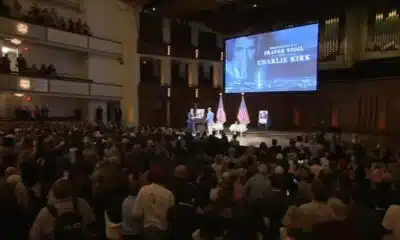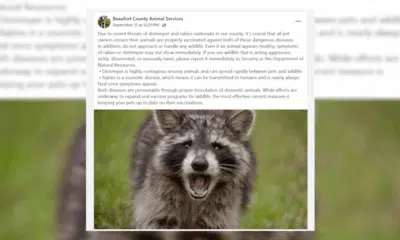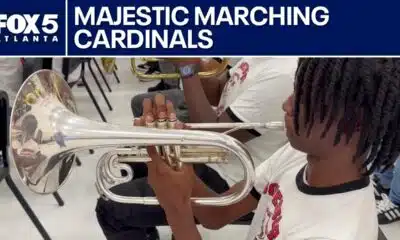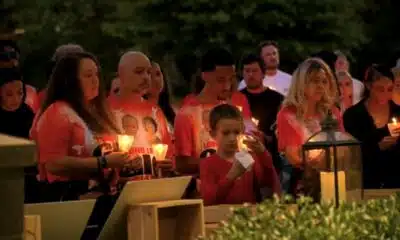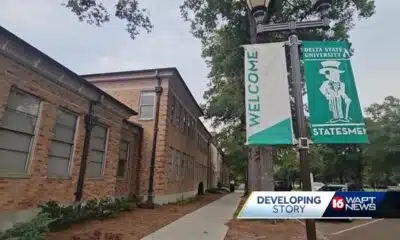News from the South - West Virginia News Feed
Watching, waiting and wondering about West Virginia’s teacher shortage
by Kathleen M. Jacobs, West Virginia Watch
June 5, 2025
As a former educator at the high school and college levels, my interest in public and private and collegiate avenues of acquiring knowledge through education remains steadfast, even though I no longer teach; instead, I write books and commentaries that I hope will not only resonate with my readers but make a difference (however slight) in the way they see the world around them, asking, “What can I do? What will my contribution be to minimizing the escalating concerns that plague educational institutions and the teachers who deliver that knowledge?”
And if all we do is look at the overwhelming task, we’ve already been defeated in answering those questions. Yes, the issues are countless and to tackle any single one of them is a monumental task. Still, we can take that thousand piece puzzle and break it down, one piece at a time or better still, put it together one piece at a time.
As I read of education’s global concerns, I also make certain to read of what is happening in my own backyard, from what the new administration didn’t do this past legislative session for students and schools and teachers to what they did do: school vaccines, for instance.
The powers that be continue to push aside the very real teacher vacancies that continue to escalate. Recently, Amelia Ferrell Knisely reported that Gov. Patrick Morrisey signed a bill creating “Troops to Teachers,” in an attempt to address West Virginia’s teacher shortage, a program that aims to put veterans in the classroom. He called the program a “common sense solution.”
Let’s remind ourselves that one reason for the teacher shortage in West Virginia is low teacher pay, compared to surrounding states. Until that discrepancy is remedied, the exodus of teachers in West Virginia will continue to rise. And the multi-leveled, arduous journey for these veterans to become certified teachers might reach beyond common sense. In fact, there’s a bit more to it than that.
George Bernard Shaw is credited with the phrase, “Those who can, do; those who can’t, teach.” In fact though, it was Aristotle who first said, “Those that can, do; those that understand, teach.” There’s a world of difference between the two sentiments. Shaw suggests that teachers are those who don’t know or haven’t learned their discipline. It’s absurd, and my suggestion would be to not repeat those words to an educator. Let’s be clear: teachers are highly skilled and experienced in their fields, with strong communication, interpersonal and pedagogical skills. The profession involves planning, delivering lessons and assessing student learning. It’s a teacher’s ability to articulate and explain complex concepts clearly, not simply perform a task, that educates and enlightens. And if we, as students, are very fortunate, it is those very teachers who choose that profession in order to share their knowledge and passion with us that catapult us to our highest heights, giving us every possible opportunity to excel and succeed.
I’m often asked why, in my commentaries, do I never offer a solution to a problem. Why do I focus only on the human factor? My answer never changes. I hone in on the human factor because I’m a humanist, because if I didn’t stay true to my core, then I would in fact be doing a disservice to those high school and college and graduate school professors who made certain that my liberal arts education was as well-rounded as they could impart. And until each and every one of us recognizes and prioritizes this undeniable truth, we cannot begin the journey to heal the wounds that scar each of us. Too, I will not disrespect my teachers or myself by even putting forth a viable solution to problems for which I’m not qualified. Are you following me?
I know that Harvard University is under the spotlight right now, but I’ve always maintained that my West Virginia education could stand with pride alongside any other respected institution of higher learning. There are countless individuals (particularly those occupying offices of power) who can and must implement programs and support educators to make certain that not only I can continue to speak those words of praise but that every learned student to follow me can say them with pride as well.
There’s a great line from the movie “Cold Mountain,” when an aged woman who lives isolated in the mountains kills a goat in order to help an escaped soldier heal: “Bird flies somewhere, picks up a seed, [expels] the seed out, plant grows. Bird’s got a job, [seed’s] got a job. And you’ve got a job.” Can we please — each of us — do our job, rather than being so self-absorbed and concerned with who gets credit for what. As elementary as it may sound, let’s work together. It’s the only way progress moves forward. Who cares who gets credit? Shouldn’t the only thing that matters be that the job got done?
GET THE MORNING HEADLINES.
West Virginia Watch is part of States Newsroom, a nonprofit news network supported by grants and a coalition of donors as a 501c(3) public charity. West Virginia Watch maintains editorial independence. Contact Editor Leann Ray for questions: info@westvirginiawatch.com.
The post Watching, waiting and wondering about West Virginia’s teacher shortage appeared first on westvirginiawatch.com
Note: The following A.I. based commentary is not part of the original article, reproduced above, but is offered in the hopes that it will promote greater media literacy and critical thinking, by making any potential bias more visible to the reader –Staff Editor.
Political Bias Rating: Centrist
This content presents a balanced, reflective perspective on education issues without adopting a distinctly partisan or ideological stance. It critiques shortcomings like low teacher pay and complex certification processes while promoting respect for educators and cooperation across stakeholders. The language emphasizes shared responsibility and human factors rather than political divides. There is no evident alignment with a particular political ideology, instead focusing on pragmatic solutions and humanism in education, which situates it near the center of the political spectrum.
News from the South - West Virginia News Feed
Ohio neighborhood fears landslide as retaining wall slips
SUMMARY: In Portsmouth, Ohio, a retaining wall has been slipping for about five years, causing fear among residents like the Yuri family who moved in just before the slip began. Despite support beams installed two years ago, cracks in the wall allow water to gush through, flooding parts of the road and raising concerns about a potential catastrophic landslide. Local councilman Shawn Dun highlights questions about the wall’s stability and estimates repair costs near $2 million, with the city seeking grants to fund the work. Residents anxiously await repairs, hoping the problem will be resolved soon to prevent disaster.
A cloud of concern hovers over one Portsmouth neighborhood. Those living along Richardson Road wonder how much longer a retaining wall will hold and keep a hillside from sliding that would damage their property. The support wall began slipping 5 years ago. A couple years later, support beams were put in place for a problem that those living along the street say is a ticking time bomb.
FULL STORY: https://wchstv.com/news/local/a-ticking-time-bomb-has-a-portsmouth-neighborhood-living-in-fear
_________________________________________
For the latest local and national news, visit our website: https://wchstv.com/
Sign up for our newsletter: https://wchstv.com/sign-up
Follow WCHS-TV on social media:
Facebook: https://www.facebook.com/eyewitnessnewscharleston/
Twitter: https://twitter.com/wchs8fox11
Instagram: https://www.instagram.com/wchs8fox11/
News from the South - West Virginia News Feed
Christian's Latest Forecast: More Dry Days; Rain Potential Late Next Week
SUMMARY: Storm Watch meteorologist Christian Boler reports mild, mostly dry weather continuing through the weekend with temperatures around 80°F and partly cloudy skies. A high-pressure system will maintain these warm, dry conditions into early next week. Some unorganized tropical rainstorms may bring isolated showers from Tuesday night into Wednesday morning, followed by a dry midweek. Saturday promises significant rainfall, helping to relieve recent dry and minor drought conditions affecting vegetation. Temperatures have shifted from below to above average this week but will dip below average later in the month. Overall, expect more dry days with rain potential late next week, improving moisture levels regionally.
FOLLOW US ON FACEBOOK AND TWITTER: https://facebook.com/WOAYNewsWatch https://twitter.com/WOAYNewsWatch.
News from the South - West Virginia News Feed
Road-widening project gets completion date, property issues remain unclear
SUMMARY: The Cross Lanes road-widening project, expanding Route 622 from Golf Mountain Road to Route 62 near Andrew Jackson Middle School, has resumed after a ten-month pause. Originally set for completion in June 2025, the new completion date is February 2027 due to delays caused by utility pole relocations. Construction is causing traffic congestion, especially around the Kroger turning light, which is being studied for timing adjustments. Despite frustrations, officials emphasize the long-term benefits. Property issues, including damage claims and easements, remain unresolved. Kanawha County lawmakers continue to provide updates as the project progresses.
Source
-
Local News6 days ago
DNA evidence found near scene of Charlie Kirk’s shooting matches suspect, FBI director says
-
News from the South - Florida News Feed7 days ago
Orlando restaurant owner invites artists to parking lot amid federal fight against street art
-
Our Mississippi Home6 days ago
Family of Curious George Creators to Visit de Grummond in Hattiesburg
-
Mississippi News Video6 days ago
The Mustard Seed
-
SuperTalk FM5 days ago
Hyde-Smith, Warnock team up to recognize Gold Star Families Remembrance Week
-
Mississippi News Video6 days ago
‘Little quiet light’: Family remembers Delta State University student found dead on campus
-
News from the South - North Carolina News Feed7 days ago
White House officials hold prayer vigil for Charlie Kirk
-
Local News5 days ago
FDA takes aim at Hims and other telehealth services in drug advertising blitz





